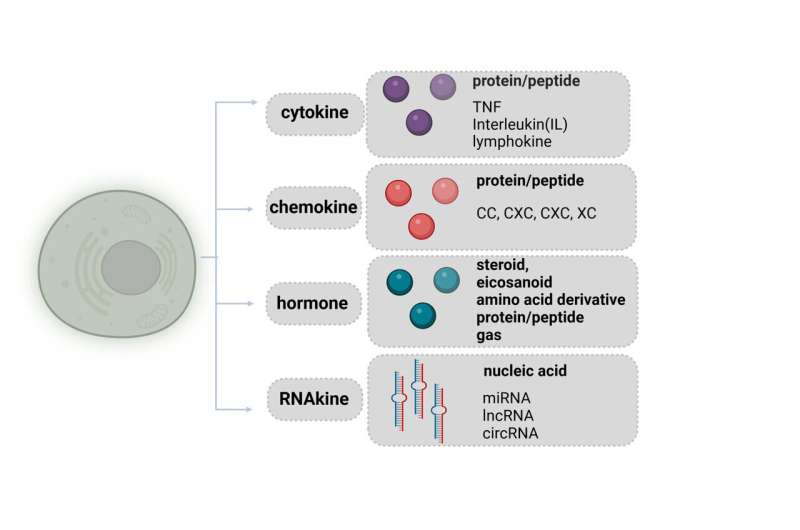
In addition to conventional secreted factors, cells also secrete ncRNA molecules (RNAkines). The molecular types of secreted factors are in bold, and representative examples or subfamilies, such as chemokines, are listed. The figure provides an overview of the diverse types of secreted factors contributing to intercellular signaling. Abbreviations: circRNA, circular RNA; lncRNA, long noncoding RNA; ncRNA, noncoding RNA; TNF, tumor necrosis factor. Credit: Chen-Yu Zhang
Throughout the history of RNA research, one can immediately notice a significant breakthrough during 2007 and 2008, in which several groups independently reported the discovery of intact noncoding RNA (ncRNA) sequences in extracellular space. Later on, the discovery of these extracellular ncRNAs led to a scope switch of RNA study, from their regulatory roles within the cells to signaling properties in cell-to-cell communications.
Extracellular ncRNAs travel in extracellular space by either associating with extracellular vesicles (EVs) or proteins. Zhang et al. first reported the signaling property of extracellular miRNAs by showing how monocyte-secreted miRNAs via EVs are taken up by recipient endothelial cells, in which they act like endogenous miRNAs regulating angiogenesis.
Since then, evidence increasingly mounts on the significant roles of extracellular miRNAs in various physiological and pathological processes. More importantly, the secretion of extracellular ncRNAs is proved to be a highly regulated process and specifically responds to various types of physiological or pathological stimuli. Therefore, extracellular ncRNAs are progressively considered a novel type of molecules that signal homeostatic changes between origin and recipient cells.
Despite the growing recognition of unique functional characteristics and relevance of extracellular ncRNAs, there remains a lack of universally accepted terminology for unequivocally identifying these molecules. The proposed terms, such as EV-RNAs and secreted RNAs, albeit have their merits, fall short of capturing their significance and characteristics as bona fide factors of intercellular communications, adding complexity and uncertainty to their understanding.
In a recent publication in Trends in Endocrinology & Metabolism, the research team of Prof. Chen-Yu Zhang (Nanjing University), Prof. Antonio Vidal-Puig (University of Cambridge), and Dr. Jing Li (Nanjing University) introduces a new nomenclature “RNAkine” for naming extracellular ncRNAs.
Leveraging the suffix “-kine,” which originally means movement and action, this unified and distinctive nomenclature vividly reflects the properties of extracellular ncRNAs as regulators in a diverse range of essential biological processes.
They state that the rationale behind coining this new term first lies in the shared biological roles with conventional signaling molecules for their actively regulated release and signaling capability. More importantly, extracellular ncRNAs cannot be simply included in the category of conventional signaling molecules since they differ from conventional signaling molecules in many aspects.
New nomenclature helps set up a unique self-contained category, encompassing all nucleic acids functioning in intercellular communications, such as circular RNAs (circRNAs) and long noncoding RNAs (lncRNAs). In addition, extracellular ncRNAs signal recipient cells in a different way. They act as endogenous ncRNAs, simultaneously targeting different components of biological networks, leading to coordinated and integrated responses.
More importantly, the term “RNAkine” emphasizes their different but co-dependent roles with conventional signaling molecules in contributing to specific physiological processes or diseases. The current evidence strongly indicates that RNAkines and conventional signaling molecules operate in concert and hierarchically.
Conventional signaling molecules often work for the central control of whole-body homeostasis. For example, leptin adjusts food intake and energy stores in response to the overall energy balance of the body. Host-derived cytokines can orchestrate the immune system during tumorigenesis to suppress tumor formation.
In contrast, RNAkines typically work to support the functionality of local tissues. A typical example is that brown adipose tissue (BAT) sends RNAkines to recruit fuel for thermogenesis in response to cold challenges. The nuanced hierarchical roles of conventional signaling molecules and RNAkines should be studied further, and the term “RNAkine” can help indicate their different regulatory scale in a certain biological process.
In summary, extracellular RNAs that are actively released and have signaling capabilities in cell-to-cell communications can be identified as RNAkines. This nomenclature provides a precise definition of extracellular RNAs, fosters consensus, and holds the potential for widespread acceptance within the scientific and clinical communities.
More information:
Jing Li et al, RNAkines are secreted messengers shaping health and disease, Trends in Endocrinology & Metabolism (2023). DOI: 10.1016/j.tem.2023.12.004
Provided by
Nanjing University School of Life Sciences
Citation:
Researchers propose ‘RNAkine’ nomenclature for naming extracellular ncRNAs (2024, January 2)
retrieved 3 January 2024
from https://phys.org/news/2024-01-rnakine-nomenclature-extracellular-ncrnas.html
This document is subject to copyright. Apart from any fair dealing for the purpose of private study or research, no
part may be reproduced without the written permission. The content is provided for information purposes only.
>>> Read full article>>>
Copyright for syndicated content belongs to the linked Source : Phys.org – https://phys.org/news/2024-01-rnakine-nomenclature-extracellular-ncrnas.html
